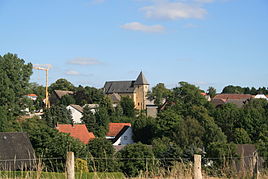Most
|
Most
City of Rüthen
|
|
|---|---|
| Coordinates: 51 ° 30 ′ 41 ″ N , 8 ° 29 ′ 21 ″ E | |
| Height : | 345 (340-400) m |
| Residents : | 375 (Dec. 31, 2014) |
| Incorporation : | 1st January 1975 |
| Postal code : | 59602 |
| Area code : | 02952 |
|
Look at most of it
|
|
Most is a district of the city of Rüthen in the Soest district in North Rhine-Westphalia . On December 31, 2014, the village had 375 inhabitants.
history
Around 1200 the place was first mentioned as "Miste" . The parish of Meiste was founded in 1191.
Michael Stappert (also Michael Stapirius ), was probably born around 1585 to 1590 in Meiste († 1663 in Grevenstein ), was a German pastor and opponent of the persecution of witches . He wrote the spectacles tract, which was only published in 1676 by the Amsterdam citizen Hermann Löher in his book Hochnötige Unterthanige Wemütige Klage Der Pious Invalid . Until 1621 he was pastor in the Sauerland town of Hirschberg (Warstein) . The Michael-Stappert-Haus and a bronze relief on the Hexenturm in Rüthen remind of his work .
In the 17th century, three members of the Eickhoff family from Meiste were executed as magicians and witches in Rüthen. In 1655 Grete Adrian was the victim of the early modern witch hunt in Rüthen.
Friend Happen (*?; †?) From Most was a defendant during the witch hunts . He was arrested on July 19, 1660 by the mayor and council of the city of Rüthen on suspicion of the vice of magic in his house and handed over to the court in the city. Friend Happen defied the torture and managed not to denounce anyone. After two months of imprisonment and three severe tortures, Freunnd Happen was acquitted on September 23, 1660.
In 1736 the St. Ursula Church was built
In 1911 the place Miste was renamed Meiste. Since the community reform, which came into effect on January 1, 1975, it has been a district of the city of Rüthen.
Population development
- 1861: 398 inhabitants
- 1939: 407 inhabitants
- 1950: 519 inhabitants
- 1961: 375 inhabitants
- 1970: 383 inhabitants
- 1974: 396 inhabitants
- 1975: 396 inhabitants
- 2000: 342 inhabitants
- 2007: 412 inhabitants
- 2011: 400 inhabitants
- 2013: 389 inhabitants
- 2014: 375 inhabitants
Economy and Infrastructure
economy
One of the largest employers in the region is right in Meiste. The masterpieces are a wood manufacturing company with about 600 employees.
traffic
A bus connection from Westfalenbus GmbH , route 673 from Rüthen to Oestereiden , runs through most.
Public facilities
- Kindergarten with one group and a total of 55 places.
- Volunteer fire brigade extinguishing group Most
- Afternoon games for young people at the church house every Tuesday.
societies
- Most rural women / Kneblinghausen / Hemmern
- TTC most
- Women's community KFD Most
- St. Sebastian Schützenbruderschaft Most of 1738 eV
- MFC Most (Master Carnival Club)
- Most of the hunting association
- Fire Department LG Most
- Comradeship of Former Soldiers Most
Kalkmagerrasen nature reserve near Rüthen-Meiste
To the northwest of Meiste lies the Kalkmagerrasen nature reserve near Rüthen-Meiste on the K 45 district road to Hemmern .
literature
- Heribert Schlueter (Ed.): Most and Kneblinghausen. Houses and their inhabitants in the past centuries. Kulturring Rüthen, Rüthen 2001, ISBN 3-00-007581-X ( sources and contributions from Rüthener Quartier 2).
Web links
Individual evidence
- ↑ Stadt & Tourismus> Ortsteile , accessed on May 17, 2016
- ↑ Stephanie Reekers: The regional development of the districts and communities of Westphalia 1817-1967 . Aschendorff, Münster Westfalen 1977, ISBN 3-402-05875-8 , p. 261 .
- ^ Federal Statistical Office (ed.): Historical municipality directory for the Federal Republic of Germany. Name, border and key number changes in municipalities, counties and administrative districts from May 27, 1970 to December 31, 1982 . W. Kohlhammer, Stuttgart / Mainz 1983, ISBN 3-17-003263-1 , p. 335 .



